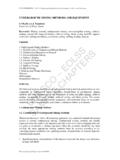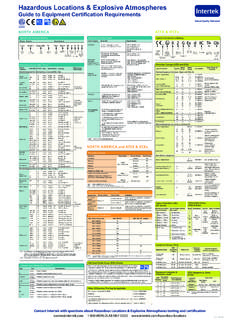Transcription of Blasting Safety – Revisiting Site Security
1 Blasting Safety Revisiting Site Security by T. S. Bajpayee, Harry C. Verakis, and Thomas E. Lobb Abstract Significant progress has been made in the reduction of serious injuries and fatalities resulting from mine Blasting operations. Despite the progress, injuries and fatalities continue to occur. A leading cause of injuries and fatalities from Blasting continues to be inadequate blast area Security . Even though significant improvements in technology have been made, insuring adequate blast area Security remains a challenge and requires constant vigilance. The advances in technology have created safer Blasting products and have improved productivity and economics by enabling large, more efficient and effective blasts. However, as blasts grow larger in size, the complexity of adequately securing the blast area increases even more. Periodically the basic fundamentals involved in Blasting Safety should be reviewed, particularly for securing a blast site regardless of the size of the planned blast.
2 Factors such as flyrock and toxic fumes must be taken into account to insure the Safety of persons and property from the results of a blast. This paper examines the factors related to injuries due to inadequate Blasting shelters and blast area Security , and identifies mitigation techniques. The key concepts are: (a) accurate determination of the bounds of the blast area, (b) clearing employees from the blast area, (c) effective access control, (d) use of adequate Blasting shelters, (e) efficient communications, and (f) training. Fundamentals are reviewed with an emphasis on analyzing task elements and identifying root causes for selected Blasting accidents. Mitigating techniques are presented along with discussions and examples. Introduction Domestic consumption of explosives during 2003 was approximately billion pounds and about 89% ( billion pounds) was used by the mining industry [USGS, 2004].
3 Blasting is a great tool in fragmenting and loosening rock and other materials for easier handling and removal by mining equipment . However, Blasting creates serious concerns for the mine operators and miners in terms of blast area Security . One thousand one hundred and thirty-one Blasting -related injuries were reported by the mining industry during the period 1978-2003 [Verakis & Lobb, 2003 with updated data]. Blast area Security accounted for of these injuries followed by premature blast ( ), flyrock ( ), misfires ( ), and fumes ( ). Figure 1 shows the distribution of Blasting -related injuries during 1978-2003. This paper presents a discussion of injuries due to lack of blast area Security and illustrates various mitigating techniques to prevent such injuries. During 1978-2003, blast area Security accounted for 41% of all Blasting related injuries reported by surface mines.
4 The corresponding figure for underground mines was 56%. The data indicate injuries from inadequate blast area Security are more prevalent in underground Blasting . Verakis & Lobb [2003 with updated data] analyzed more recent data (1994-2003) to assess any changes in the role of blast area Security . During this period, blast area Security accounted for nearly of all Blasting -related injuries in surface and underground mines. Figure 1 also shows the distribution of Blasting -related injuries during 1994-2003. Injuries due to inadequate blast area Security continue to be a major Safety concern. Mitigating techniques for preventing injuries due to inadequate blast area Security are discussed in this paper. The injuries primarily result from failure to identify and clear the blast area, inadequate guarding, failure to communicate or follow instructions, and inadequate or improper cover.
5 Compliance to an effective blast area Security protocol plays a key role in preventing injuries to miners, visitors, neighbors, and trespassers. Blast Area One of the greatest challenges, which a blaster faces in mining and construction Blasting , is to accurately determine the bounds of the blast area. This is particularly true in geologically disturbed rock. A blaster s decision in estimating the bounds of the blast area is greatly influenced by the engineering design of the blast, geology of the blast, regulatory requirements, and company policy. Schneider [1995] stated that a blaster must make an estimate of the maximum possible distance flyrock could travel from a shot. Furthermore, a blaster should not assume that a shot being fired will behave like other shots previously fired at the same operation.
6 For surface and underground metal-nonmetal mines, Title 30 Code of Federal Regulations (30 CFR) and defines blast area as the area near Blasting operations in which concussion or flying material may cause injury. The following factors shall be considered to determine the blast area: Geology or material to be blasted, Blast pattern, Burden, depth, diameter, and angle of the holes, Blasting experience of the mine, Delay systems, powder factor, and pounds per delay, Type and amount of explosive material, and Type and amount of stemming. The Federal Office of Surface mining (OSM) regulations [30 CFR and ] help to characterize the bounds of the blast area by specifying that flyrock shall not be cast from the Blasting site More than one-half the distance to the nearest dwelling or other occupied structure, Beyond the area of control required under 30 CFR (c), or Beyond the permit boundary.
7 Similar requirements are prescribed by many coal mining states such as Colorado, Illinois, Kentucky, New Mexico, Ohio, Pennsylvania, Utah, Virginia, West Virginia, and Wyoming. The bounds of a blast area should be adequately determined for each blast. Flyrock could travel beyond an inadequately defined blast area and cause injury. In Campbell County, TN, flyrock traveled beyond the blast area resulting in a fatal injury to a motorist traveling on interstate 75 [Shea & Clark, 1998]. The bounds of the blast area were not adequately determined for this blast. In a coal mine blast, flyrock traveled 900 feet and landed beyond the permit boundary causing a fatal injury [MSHA, 1990a]. During a construction Blasting operation near Marlboro, NY, flyrock was showered on passing motorists on Route 9 W about 180 feet from the blast pit. This incident resulted in property damage and injury.
8 There are numerous instances where the bounds of the blast area were not accurately determined, resulting in injury, or property damage. There are many cases of close calls where accidents were narrowly missed. Blast area Security in underground mines is much more complex than surface Blasting . It requires a thorough understanding of ventilation, roof characteristics, and the roof control plan of the mine. The bounds of the blast area need to be adjusted accordingly. Blasting could cause ground fall in adjacent entries, and exposure to smoke, dust, or toxic fumes. All employees must be removed from such adjacent entries or other affected airways. Post-blast roof fall and exposure to fumes have caused several accidents. Fundamental task-elements of a blast area Security system A blast area Security system is the means by which a mine operator prevents injury to people or damage to equipment when a scheduled blast is detonated [Fletcher & D Andrea, 1987].
9 Most Blasting accidents in surface and underground mines occur during scheduled Blasting and are due to inadequate blast area Security . MSHA accident data reveal that the Blasting crew and blasters often suffer serious injuries due to inadequacy of the shelter used for protection from blasts. The functional task-elements of a blast area Security system are (a) estimate the flyrock zone based on shot conditions, and add a factor of Safety to determine the bounds of the blast area, (b) clear all employees, contractors, and visitors from the blast area, (c) post guards at the access points to prevent unauthorized entry, (d) use adequate Blasting shelters for employees whose presence is required in the blast area, and (e) maintain effective communication with guards, mine foreman, and other employees. Determination of the bounds of the blast area Correct assessment of the bounds of the blast area is the first step in ensuring Safety .
10 The blaster should determine the bounds of the blast area after a careful consideration of such information as the driller s log, blasthole deviation data, laser-profile data, slant of the holes, blasthole loading data, condition of the highwall, presence of overhangs, back-breaks, voids, weathering, and variations in the local geology. A blaster usually understands that in a given surface or underground mine, blast area could vary from shot to shot. There are many occurrences of flyrock landing beyond the property or permit boundary in surface Blasting . Such occurrences demonstrate incorrect determination of the bounds of the blast area. Flyrock from a limestone quarry traveled about 930 ft and fatally injured a resident who was mowing grass on his property [MSHA 1990b]. In underground mining situations, the mine roof conditions, ground support system, and ventilation are important factors in determining the extent of the blast area.














